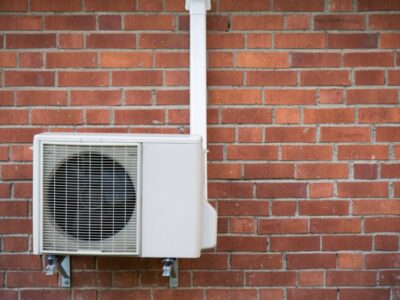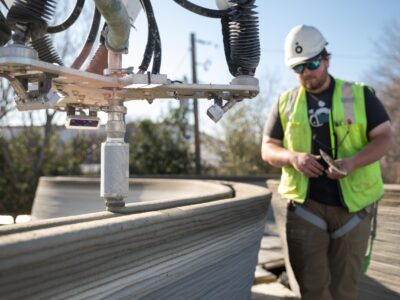(Bloomberg) —
In the past year alone, floods washed away nearly one million houses in Pakistan, heat waves killed hundreds of people in under-air-conditioned London and Hurricane Ian tore apart homes along the US East Coast. From record-breaking temperatures to wildfires and gale-force winds, housing all over the world is being put to the test by a changing climate.
Climate impacts are also making it more expensive to insure homes against these threats. In the US, for example, a survey last year by online insurance marketplace Policygenius found that 90% of more than 8,000 insured homes had seen an increase in premiums, which were up by an average of 12% in May from a year earlier. Increases were steepest in disaster-prone states that include Washington, Colorado and Arkansas — each of which saw premiums climb roughly 18%.
At the intersection of concerns over climate impacts and insurance premiums is a growing cohort of companies focused on developing more resilient housing, including architectural designs more suited to surviving water, fire and wind.
“Resiliency is very important,” says Anne Cope, chief engineer at the Insurance Institute for Business and Home Safety (IBHS), a nonprofit research institute in South Carolina that advises builders and homeowners on climate-resilient construction. “It’s a matter of adapting and understanding the climate that we live in and being prepared for that, so a bad day isn’t a tragic day.”
Here are four examples of architectural designs meant to better withstand climate impacts.
A house that floats in floods
Following destructive flooding in Japan in 2015, real estate developer Ichijo Co. designed a “floating house” to guard against future threats. Once water levels exceed roughly 1 meter (3.3 feet), the entire building essentially rises to the water’s surface. When the water retreats, the building returns to its original location with a margin of error smaller than the length of a human thumb, thanks to four poles that connect the house to the ground and stabilize its movement.
Ichijo makes another design of its house that doesn’t float, but instead directs floodwater to a designated indoor flooding zone to mitigate damage after water levels exceed 1 meter. Both designs come equipped with waterproof windows and doors, as well as a special drainage system to prevent overflows in the kitchen, toilets and bathtubs. The company says it has built more than 1,000 flood-resilient homes since 2020, but does not break out how many of its sales were of floating homes.
A house to keep the heat out (or in)
In Castle Rock, Colorado, a house nestled among the hills looks just like any other: grey exterior, pitched roof, plentiful windows. But the walls of this particular house, designed by Golden-based startup Colorado Earth, were built using compressed earth blocks, made largely from a sandy-clay mixture. Colorado Earth engineer Lisa Morey adapted the technique, which originated in ancient Jordan, to meet modern building codes. It creates walls that are essentially fire-proof — ironic, since the house is owned by a local firefighter.
Morey says the slow pace at which heat is transferred through the house’s 10-inch-thick walls — about one inch per hour — means that they are also adept at keeping heat in during a cold spell and out during a heat wave. In Castle Rock, where February temperatures drop to an average low of 18F (-7C), sensor data collected by Colorado Earth has found that the entire house stays at a constant 68F (20C) with sunlight and a wood-burning stove.
A house that can handle a hurricane
North Carolina’s Deltec Homes is known for houses that can withstand winds of up to 190 miles per hour. Now the company is intent on upping its game: The newest Deltec model, still under development, is engineered to handle winds of up to 225 mph.
Deltec attributes its structures’ resilience largely to a curvilinear shape that helps offset wind pressure by about 30%. The company says it also chooses construction materials twice as robust as what is typically required by building codes.
As storms intensify, interest in Deltec homes is climbing: The company’s president says sales have increased by roughly 50% since 2018. To date, Deltec has built more than 5,500 hurricane-resilient homes across 32 countries, including this 2,616-square-foot house in San Salvador in the Bahamas.
A house with strength under fire
Wildfire is one of the most common climate-related disasters in the US: One in five single-family houses are at risk of experiencing one over the next 30 years. That’s why IBHS comes up with step-by-step guidelines on how to build a wildfire-ready home.
After losing his Paradise, California, house to one of the deadliest wildfires in US history in 2019, Gary Ledbetter, 59, has been using the IBHS guidelines to inform his rebuild with one goal in mind: never seeing it burn. That means jumping on a slew of fire-resilient features that start at the top. Ledbetter’s new 2,200-square-foot house has what’s known as a “Class A” roof, the highest rating in fire tolerance, and is mounted with sprinklers. Ember-resistant vents and fire-proof doors are installed, too.
Being prepared for wildfires also means rethinking the landscaping. Ledbetter eschews window flower boxes, which could potentially ignite in a blaze. Instead, his home is surrounded by a 5-foot non-combustible zone made from concrete and gravel.
That preparation comes with a price tag: Ledbetter’s fire-proof garage door, for example, costs about 50% more than conventional ones. But he says the upgrades made it possible for him to get home insurance, something that residents in this wildfire-prone town can’t take for granted.
“Most companies will not write a policy in Paradise,” he says. “Had we not got all of the improvements and efforts to create a resilient home, the underwriter probably would not have touched us.”
To contact the authors of this story:
Coco Liu in New York at yliu1640@bloomberg.net
Grace Huang in Tokyo at xhuang66@bloomberg.net
© 2023 Bloomberg L.P.





